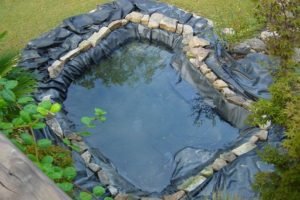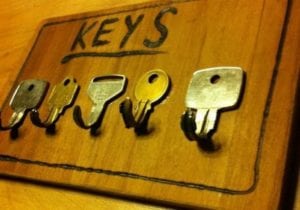Last Updated on October 22, 2025 by teamobn
Pallet projects that sell can turn spare wood into profit. You’re free to start with basic tools and reclaimed pallets. Each of these five builds comes with clear steps and a full materials list.
You’ll also learn why buyers can’t resist these creations. Before you dive into the builds, make sure you’ve got the right materials lined up.
If you’re new to sourcing reclaimed pallets, here’s a handy guide on where to find free wood pallets near you so you can start each project on budget.
Contents
5 Pallet Projects That Sell
By upcycling wooden pallets into incredible furniture, you can make some side profit. Below are notable pallet projects that sell in many markets.
DIY Pallet Coffee Table
A pallet coffee table repurposes two or more wooden pallets into a low-profile table ideal for living rooms. You build it using reclaimed pallet wood. To make teardown faster and preserve more usable boards, consider using a DIY pallet breaker tool for easy disassembly before you start.
It brings a rustic or industrial look to modern spaces. The design relies on simple joinery and off-the-shelf casters. You’ll create a sturdy surface for drinks, books, or décor.
This piece highlights the charm of distressed wood and visible grain. The open pallet slats give easy under-table storage. It stands out among pallet projects that sell because it balances form and function. You can finish it in a weekend.
This table showcases how reclaimed materials can become stylish furniture. It makes a compelling statement piece in any living area. The result feels custom and unique to every home.
Materials and Tools
- 2 wooden pallets
- 4 locking casters
- Sandpaper (80 and 120 grit)
- Wood screws (2.5 inch)
- Wood stain or paint
- Paintbrush or roller
- Drill with Phillips bit
- Circular saw or handsaw
- Measuring tape
Step-by-Step Guide
- Inspect and clean pallets. Remove nails or staples with a pry bar and hammer.
- Cut pallets to size with a circular saw or handsaw if needed. Make sure edges are straight.
- Sand surfaces starting with 80 grit then smooth with 120 grit.
- Attach pallets together using wood screws driven through the top pallet into the bottom one.
- Apply wood stain or paint with a brush or roller and let it dry fully.
- Flip the pallets and secure locking casters at each corner with screws.
- Level the table and tighten all fasteners before use.
Why It Sells
People crave pallet coffee tables for their blend of character and affordability. You’ll find the worn textures and earthy tones suit many décor styles. Buyers appreciate the low cost and DIY backstory.

Pallet Garden Planter Bench
What It Is
A pallet garden planter bench transforms repurposed pallet wood into a multifunctional outdoor seat with built-in plant beds. You construct a sturdy bench frame by stacking and securing weather-resistant pallet boards.
The integrated planter boxes on each side or along the backrest hold flowers, herbs, or small shrubs. You’ll sand and seal the wood to withstand sun and rain. Its rustic charm and customizable planters let gardeners display living accents within arm’s reach.
The bench design features wide seating planks that accommodate two or more people comfortably. Its modular planter sections can be lined with landscape fabric and filled with soil for proper drainage.
This piece stands out among pallet projects that sell because it combines furniture and garden functionality in one attractive build.
Materials and Tools
- 3–4 weather-resistant wooden pallets
- 2×4 pressure-treated lumber for reinforcement
- 3″ exterior-grade wood screws
- Drill/driver with Phillips bit
- Circular saw
- Hammer and pry bar
- Sandpaper (80 and 120 grit)
- Exterior wood stain or sealant
- Paintbrush or roller
- Tape measure and carpenter’s square
- Landscape fabric and staple gun
- Potting soil and plants
- Level
- Safety gloves and goggles
Step-by-Step Guide
- Disassemble pallets. Use a pry bar and hammer to remove boards and nails.
- Cut boards to size. Measure lengths for the bench seat, legs, and planter box sides.
- Assemble the frame. Lay 2×4 supports on a flat surface. Align seat boards across the supports. Fasten with 3″ screws.
- Build planter boxes. Screw boards together into rectangular boxes sized for either side of the bench or along the back.
- Attach planter boxes. Position them on the frame. Drive screws through the box bottoms into the seat supports.
- Line boxes with landscape fabric. Staple the fabric inside each planter to hold soil and allow drainage.
- Sand all surfaces. Start with 80-grit to remove rough patches, then finish with 120-grit for smoothness.
- Apply stain or sealant. Brush or roll on an even coat. Let it dry fully in a well-ventilated area.
- Fill planters. Add potting soil and arrange herbs, flowers, or small shrubs. Water lightly.
- Final checks. Use a level to ensure the bench sits flat. Tighten any loose screws before use.
Why It Sells
Homeowners and garden enthusiasts love the pallet garden planter bench for its blend of seating and greenery. They appreciate the way it maximizes small patios, decks, or yard spaces by combining a sturdy bench with plant displays.
Pallet Wine Rack
What It Is
A pallet wine rack repurposes pallet slats into a functional wall-mounted or standing storage unit. You assemble reclaimed wood boards to create shelves that cradle wine bottles horizontally.
The design often features angled cubbies for secure bottle support. It showcases the rough grain and nail holes that define reclaimed pallets. You can stain or paint it to suit contemporary or rustic décor. Some racks include space for wine glasses or bar tools. They range from compact vertical towers to wide multi-bottle displays.
This rack joins other popular pallet projects that sell. You can build it in a single afternoon. The finished piece brings artisanal character to kitchens, dining rooms, and entertaining spaces. It exemplifies one of the highest-demand pallet projects that sell.
Materials and Tools
- 1 wooden pallet or equivalent pallet boards
- Measuring tape and pencil
- Circular saw or handsaw
- Pry bar and hammer
- Drill/driver with Phillips bit
- Wood screws (2.5″)
- Sandpaper (80 and 120 grit)
- Wood stain or paint
- Paintbrush or foam roller
- Level
- Stud finder (for wall mount)
- Anchors and screws for drywall (if wall-mounted)
Step-by-Step Guide
- Disassemble pallet. Remove boards using pry bar and hammer.
- Plan rack size. Measure height and width, then mark cuts.
- Cut boards. Use circular saw to trim to size.
- Sand boards. Start with 80-grit, then finish with 120-grit.
- Assemble shelves. Lay boards on edge supports and secure with screws.
- Add cubbies. Space slats evenly for bottle slots and fasten.
- Stain or paint. Brush on a coat and let dry fully.
- Install hardware. Attach brackets or casters; use anchors for wall mounts.
- Position rack. Ensure it sits level or mounts straight.
- Load bottles. Place bottles horizontally in each cubby.
Why It Sells
People love the pallet wine rack for its blend of rustic charm and home bar utility. You’re offering a stylish storage solution at a fraction of retail cost. Shoppers admire the visible grain and distressed details that only reclaimed wood can provide.

Pallet Floating Shelves
What It Is
A pallet floating shelf repurposes pallet slats into sleek wall-mounted planks with hidden supports. You strip pallets to individual boards. You cut boards to matching lengths. You build a cleat system that lets shelves slide on and off easily. The result looks like wood hovering on the wall.
It adds rustic or modern flair in kitchens, living rooms, and hallways. The minimal hardware keeps the focus on natural grain and patina. It’s a top pick among pallet projects that sell. You can finish it in a few hours with basic tools. This simple design shows how scrap wood can become functional décor.
Materials and Tools
- 1 wooden pallet
- Tape measure and pencil
- Circular saw or handsaw
- Pry bar and hammer
- Drill/driver with ¼” bit and Phillips bit
- Wood screws (2½”)
- Sandpaper (80 and 120 grit)
- Exterior or interior wood stain or paint
- Paintbrush or foam roller
- Level
- Wall anchors and screws
- Safety goggles and gloves
Step-by-Step Guide
- Disassemble the pallet. Remove slats with pry bar and hammer.
- Cut slats to desired shelf lengths using a saw.
- Sand surfaces smooth, starting with 80-grit, then 120-grit.
- Build the wall cleat by cutting a 2×4 to shelf width.
- Fasten the cleat to wall studs using anchors and screws.
- Attach a matching cleat strip to the back of each shelf plank.
- Stain or paint shelves and cleats. Let them dry fully.
- Slide shelves onto the wall cleat. Check for level and adjust.
Why It Sells
Buyers love pallet floating shelves for their blend of style and affordability. They clear floor space and keep clutter off counters. The floating effect appeals to modern and farmhouse décor fans. They value the warmth of reclaimed wood without the retail markup. Sellers can offer various lengths, depths, and finishes to match any room.
Pallet Headboard
What It Is
A pallet headboard transforms reclaimed pallet slats into a stylish backrest for beds. You’re mounting it behind a bed frame or directly to the wall. The design highlights natural wood grain, knots, and nail holes. It fits farmhouse, industrial, and modern spaces. You can build it in any width to suit twin, queen, or king beds.
The slats align horizontally or vertically for varied looks. You sand and finish the surface with stain or paint. This project uses simple hardware and joinery. It creates a custom statement piece that feels high-end but costs little. It remains one of the top pallet projects that sell due to its blend of practicality and style.

Materials and Tools
- 2–3 wooden pallets
- Measuring tape and pencil
- Circular saw or handsaw
- Pry bar and hammer
- Drill/driver with Phillips bit
- Wood screws (2½”)
- Sandpaper (80 and 120 grit)
- Wood stain or paint
- Paintbrush or roller
- Wall brackets or cleats
- Stud finder and level
- Safety gloves and goggles
Step-by-Step Guide
- Disassemble pallets. Use pry bar and hammer to remove boards and nails.
- Cut slats to match bed width. Trim edges with a saw.
- Sand all surfaces. Start with 80-grit, finish with 120-grit.
- Arrange slats on a flat surface in your chosen pattern.
- Screw slats together using wood screws spaced evenly.
- Attach mounting brackets or cleats to the back of the headboard.
- Locate wall studs and secure the headboard to the wall.
- Apply stain or paint. Let it dry fully before hanging.
Why It Sells
Homeowners love pallet headboards for their unique blend of charm and affordability. They appreciate the way reclaimed wood brings warmth and texture to any bedroom.
Buyers can customize size, finish, and orientation to match their décor. They value the low cost compared to mass-produced headboards. For step-by-step instructions, see our detailed pallet headboard tutorial that walks you through every stage of the build.
Conclusion
These five pallet projects that sell prove that reclaimed wood can become high-demand décor and furniture. You’re able to customize each build to match any style and budget. Start turning spare pallets into profit and watch your creations fly off the shelves.
For a functional pallet project, check out how to build a functional pallet wagon.






